 웹 내용 전시
웹 내용 전시

Basic stance
Contributing to the sustainable development of society and conducting environmentally-friendly business operations are essential issues that need to be addressed in modern business management. The Advantest Group works to develop products from the perspective of environmental conservation while prioritizing high precision and high quality, and certifies products that are environmentally-friendly in terms of the three key aspects of energy saving and resource conservation, improving recyclability, and elimination of hazardous substances as green products.
There is demand in society for the supply of green products because they provide both a reduction in the environmental footprint as well as an improvement in economic value. The Group is developing green products in response to these demands and based on the belief that these products will be beneficial for its customers.
Development flow of green products
At the Advantest Group, all new products undergo a product environmental assessment.
During the environmental assessment, products are assessed from various aspects, including energy savings, the number of parts used, product size, recyclable design, and elimination of hazardous substances. Products that meet the Voluntary Standards for Green Products are certified as green products and are awarded with an Eco Label (type II).
Development flow of green products
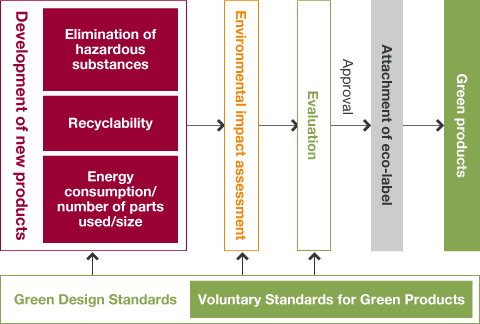
Advantest Group Eco Label
The Advantest Group Eco Label features an original three-color design representing energy and resource conservation, recyclable design, and elimination of hazardous substances through green procurement.
Energy and Resource Conservation Voluntary Standards
Voluntary Standards
- Energy-saving design
- Reduced-material design
- Miniaturized design
Recyclable Design
Voluntary Standards
- Design with renewable resin materials
- Design for ease of disassembly
- Release of information on disposal
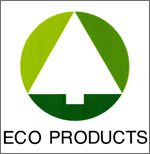
Elimination of Hazardous Substances
(Green Procurement)
Voluntary Standards
- Improved rates of green procurement
- Elimination of banned substances
Energy and resource conservation
We aim to reduce the environmental footprint of our products through system designs that offer energy efficiency, feature ecologically-sound components and materials, and result in units that are smaller in size.
Recyclable desig
Our recyclable design initiatives involve releasing of information on parts that require care during disposal, while also seeking to use recyclable materials for resin parts designed in-house. Moreover, we make sure that products are easy to disassemble with standard tools in preparation for recycling, and we use batteries displaying a recycling symbol.
Elimination of hazardous substances (green procurement
To avoid using hazardous substances in products, we have established Group standards on banned substances based on the IEC 62474 standard, and conduct studies on the hazardous substances contained in the parts and materials used in our products.
Green products certified during fiscal 2012
The following products are among those certified as green products that we supplied to customers during fiscal 2012.
- T5511
- T5811
- TAS7500
- CX1000D/P
- Five types of T2000 module products
Introducing our Green Products
T5811 Memory Test System
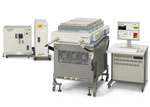
T5811
Focus on Memory Core Test Dramatically Reduces COT
Dynamic random access memory (DRAM) represents the predominant type of commodity memory device found in client-servers and mobile devices, and is also used extensively in many electronics device fields. We envisage ongoing market expansion for DRAM modules, given solid bit growth in DDR3-SDRAM and DDR4-SDRAM, main memory of PC. Meanwhile, we also anticipate increasing demand for LPDDR2-SDRAM and LPDDR3-SDRAM modules amid growing low-power requirements for smartphones and tablet devices. Yet ongoing commoditization of DRAM modules has been driving down prices and forcing DRAM-manufacturers to seek greater COT (cost of test) savings on their volume production lines. Accordingly, in regard to what is now the primary means of backend DRAM testing involving a 2-pass test, divided into at-speed testing and memory core testing, the market is calling for solutions that enable lower COT in the memory core testing phase where testing speeds need not be particularly high.
Designed with a focus on memory core testing, our T5811 memory test system greatly reduces COT*1.
(*1) COT = Cost of Test
Lighter, smaller and more energy-efficient than earlier models
In comparison to previous models, our T5811 memory test system contains 82% less component volume than earlier models, while also featuring a 92% smaller footprint and consuming 88% less power. To achieve this, we engaged in development efforts focused on delivering optimal features and performance in the area of memory core testing, and have also equipped the system with recently-developed Enhanced Test Module (ETM)*2 technology.
(*2) ETM = Enhanced Test Module
ETM Technology Significantly Reduces COT
The T5811 is equipped with ETM technology, a proprietary BOST*3 configuration, and is designed so that most test functions of the system are mounted into the motherboard at high density in close proximity to the DUTs*4 with the aim of keeping down the costs of the whole systems, and thereby resulting in lighter, smaller and more energy-efficient systems.
Moreover, through a simple switch-out of the ETM, users are able to easily upgrade the tester unit as necessary to achieve added functionality and improved test speed, thereby enabling them to keep equipment investment costs in check through prolonged tester unit operability.
(*3) BOST = Built-Out Self Test
(*4) DUT = Device under Test
In this manner, the Advantest Group will continue to advance with manufacturing from the customers’ perspective.
Aiming to develop environmentally-sound products

Common Technology Group
Masaru Doi
The T5811 marks the beginnings of our efforts to bring about low-COT solutions focused on memory core testing. Although such initiatives remain in the development stage, we are now more aware of how introducing low-COT systems can closely link with our objective of delivering environmentally-sound products. In other words, it is now evident that we need to come up with smaller and lighter systems that consume less energy. In developing the T5811 we have been faced with the task of coming up with a memory tester specifically geared toward testing of memory core in line with such customer demands, while also delivering a unit offering sophisticated tester functions while not sacrificing performance. Through such efforts, we have developed a unit that is significantly lighter, smaller and more energy efficient. Going forward, we will continue working to develop products that offer advantages to our customers as well as making social contribution through developing environmentally-sound, Green Products.
Performance comparison
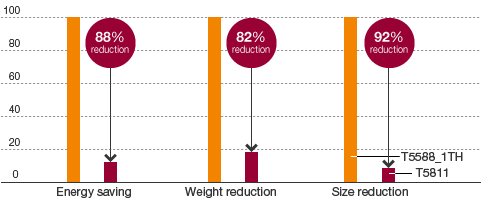
Comparing products’ environmental information
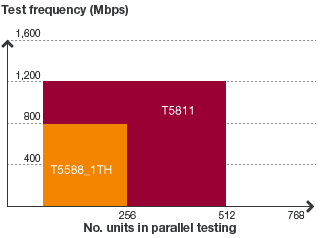
Promoting Sales of Green Products
Many companies in recent years have been increasingly engaging in environmentally-responsible management practices. Likewise, the Advantest Group has adopted an environmental policy that inspires us to deliver green products while helping customers reduce their environmental footprints. Based on these aims, the Group is pursuing product development in accordance with Green Design Standards formed on the basis of product environmental assessments, while also providing products that have been certified in accordance with our proprietary green product standards.
Fiscal 2012 results
In fiscal 2010, the Group set annual targets for its green product unit sales ratio. As of fiscal 2012, the final year of that initiative, we have fully achieved our target of 100% green product sales, meaning that we have successfully reached our goal of having sold no non-green certified items during that year.
In addition, product photographs posted on our website now feature Eco Labels to indicate that the respective products are green certified. This helps enhance our corporate image while enabling customers to more readily opt for green products. We have also begun to clearly showcase environmental footprint reduction data on product presentation materials.
Moreover, we continued to pursue initiatives centered on the theme of enabling our customers to reduce environmental loads. In that regard, we have been working to stimulate sales of our T2000 EPP (Enhanced Performance Package) testing system which offers significantly better performance in terms of power consumption for lower CO2 emissions, and have also been seeking to encourage reuse of High Fidelity Tester Access Fixtures (HIFIX) and use of returnable packaging materials.
In fiscal 2013, we are embarking on a new two-year plan, thereby setting fresh objectives aiming to help our customers further reduce environmental loads while working to execute the plan.
Green product sales ratio (unit-base)
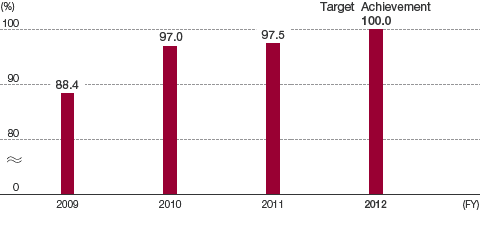
Compliance with EU-RoHS Directive
Advantest's Statement on the EU-RoHS Directive
In complying with environmental laws and regulations, the Advantest Group is working toward eliminating use of hazardous materials while also pursuing environmental conservation efforts that entail reducing consumption of energy and resources. More specifically, we have been working with our suppliers since September 2003 on initiatives to investigate and eliminate use of restricted hazardous materials.
We are in compliance with the European RoHS Directive*.
Advantest's semiconductor testers and handlers are classified as Large-Scale Stationary Industrial Tools (LSSIT) and as such are exempt from the EU-RoHS directive. Nevertheless, on the basis of our commitment to environmental conservation we continue working toward further elimination of hazardous substances from these product lines.
* Certain exemptions aside, the European Union Directive 2011/65/EU on the restriction of the use of certain hazardous substances (RoHS) in electrical and electronic equipment and respective revisions currently restrict the use of six substances in such products:
- Lead (Pb)
- Hexavalent chromium (Cr VI)
- Mercury (Hg)
- Polybrominated biphenyl (PBB)
- Cadmium (Cd)
- Polybrominated diphenyl ether (PBDE)


